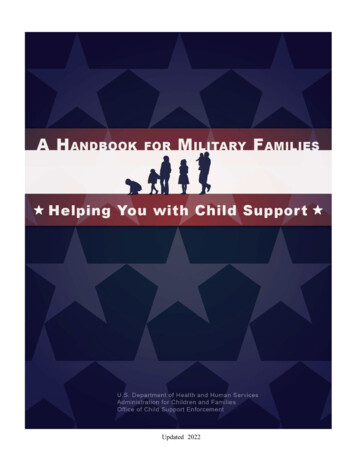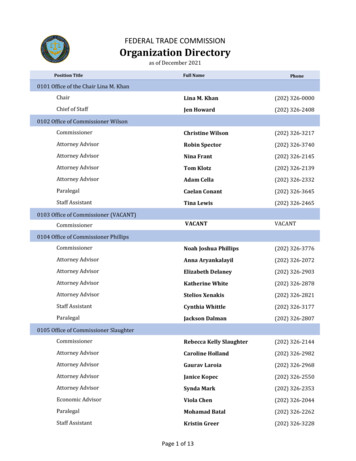
Transcription
Updated 2022
A Handbook for Military FamiliesForewordIf you are an active-duty service member, a member of the National Guard or Reserves, or amilitary family member, I want to thank you for serving our country.Military service provides rewarding opportunities and experiences. Military life events can alsostrain family relationships. Military members move much more frequently than civilians do andare often separated from their families for months at a time. Domestic issues may arise at any pointduring a member’s military service, but they seem especially prevalent at pre-deployment, duringdeployment, and after the return home. According to Pentagon statistics, the start of OperationEnduring Freedom in Afghanistan brought an increase in military divorces.1Although the divorce rate has declined the past 10 years, it still remains higher than it was prior to2001. 2 The divorce rate impacts child support because approximately 32.2% of the Active Dutyand Selected Reserve population in 2019 were married with children and 5.9% were single withchildren. 3All branches of the armed forces offer parenting programs and resources to strengthen militaryfamilies. This handbook supplements those resources by providing information you might needregarding paternity establishment, child support, access and visitation, and child custody. First linesupervisors and military commanders may also find this a helpful addition to a leadership toolkit.We understand this may be uncharted territory for you, so we have included a Frequently AskedQuestions section at the end of each chapter and a glossary of terms at the end of the publication.For more detailed information, please read the general Child Support Handbook that is availableon the federal Office of Child Support Enforcement website in both ial/handbook-child-support-enforcement) and e members do not need the added stress of family issues when they are trying to safeguardour freedom. While studies show that children do better when they are cared for and supported bytwo loving parents, we know that being together is not always the best option. We hope thishandbook will help your child support issues go more smoothly.Tanguler GrayCommissioner, Office of Child Support EnforcementSee tary-divorce-rate-down-slightly-in-2012.html. The militarydivorce rate in 2001 was 2.6%. With the start of Operation Enduring Freedom in 2001, that rate increased. By 2009,the military divorce rate had climbed to 3.6%. The increase was higher in some branches; for example, the Armydivorce rate rose by almost 50%. Since 2009, the overall military divorce rate for active duty members has steadilydecreased to 3.1% in 2019.2See Department of Defense, 2019 Demographics: Profile of the Military Community. The divorce rates released bythe Pentagon do not include data on Coast Guard personnel, Reserveand National Guard members, or on servicemembers who divorced after leaving the military. Military and civilian divorce rates cannot be accurately compared tothe total U.S. divorce rate due to the differences in how they are tracked.3See Center for Disease Control, National Marriage and Divorce Rate Trends (provisional arriage-divorce-rates-00-18.pdf.1i
A Handbook for Military FamiliesTable of ContentsContentsForeword. iTable of Contents . iiOrganization of the Handbook . 1For More Information . 2I.The Child Support Program. 3Mission of the Child Support Program. 3Services Provided by the Child Support Program. 3Recipients of Child Support Services. 4Focus of Services. 4Legal Representation . 4Questions and Answers for Custodial Parents. 5Questions and Answers for Noncustodial Parents . 5II.Location of Noncustodial Parents . 8State and Federal Locate Resources. 8Military Locate Resources. 9Questions and Answers for Custodial Parents. 11Questions and Answers for Noncustodial Parents . 11III.Paternity Establishment. 12Acknowledgment of Paternity . 12Court Order of Paternity. 12Genetic Testing. 12DEERS Enrollment for Health Care . 13Questions and Answers for Custodial Parents. 14Questions and Answers for Noncustodial Parents . 16IV.Support Establishment. 22Family Support Guidelines Under Service Regulations . 22Voluntary Allotment. 28Establishing a Legal Order. 28State Child Support Guidelines. 28ii
A Handbook for Military FamiliesDetermining Income of a Military Member. 29Medical Support . 30Obtaining Medical Support from Military Personnel. 30Enrollment in DEERS. 30Medical Care through TRICARE . 32Confirmation of Enrollment of Child in DEERS and TRICARE. 33State Legal Proceedings for Establishment of a Support Obligation. 34Duration of Support Obligation. 34Questions and Answers for Custodial Parents. 34Questions and Answers for Noncustodial Parents . 38V.Support Enforcement . 41Military Regulations Governing Support Enforcement. 41Military Voluntary Allotment. 41Income Withholding . 42Benefits of Income Withholding. 42Limits on the Amount that can be Withheld . 42Military Income Subject to Withholding Under State Law. 43Defense Finance and Accounting Service (DFAS) . 43National Guard or Reserve Members. 44Movement from Active Duty to Retired Status . 44Federal Statutory Allotment for Child Support. 44The Uniformed Services Former Spouses’ Protection Act . 45Overview. 45Initiation of Enforcement under the USFSPA. 45Application Form. 46Court Order. 46Maximum Payment Amount. 47Other Enforcement Methods . 47Federal Income Tax Refund Offset. 48Eligibility . 48Due Process Requirements. 48Distributions of Monies Withheld from Refund. 48iii
A Handbook for Military FamiliesState Income Tax Refund Offset. 48Liens on Property. 49Attachment of a Financial Institution Account . 49License Suspension. 49Passport Denial. 49Due Process Requirements. 50Steps to Take if a Passport is Denied. 50Military and Interest Rates . 51Civil Contempt. 51State and Federal Criminal Nonsupport . 51Enforcing Medical Support Through Tricare. 52Who is Eligible? . 52Process for Enrollment . 52Options for Coverage. 53Obtaining Health Care. 53Dental Coverage. 53Questions and Answers for Custodial Parents. 54Questions and Answers for Noncustodial Parents . 56VI.Modifying Existing Support. 61Questions and Answers for Custodial Parents. 62Questions and Answers for Noncustodial Parents . 63VII.Intergovernmental Cooperation. 65Part One: Interstate/Tribal Cooperation. 65Important Terms. 65Overview of UIFSA. 66One Order World. 66Evidentiary Provisions. 67One-State and Two-State Proceedings . 67Child and Spousal Support . 68Paternity Establishment. 68One-State Long-Arm Action . 68Two-State Action . 68iv
A Handbook for Military FamiliesSupport Establishment . 68One-State Long-Arm Action . 69Two-State Action . 69Support Enforcement. 69Enforcement When There is One Order . 69Enforcement When There are Multiple Orders. 69Enforcement Remedies. 69Modification. 70Exceptions to Modification Rules . 71Registration for Modification. 71Limitations on Modification . 71Applicable Support Guidelines. 71The Full Faith and Credit for Child Support Orders Act . 72Tribal Cases. 72Questions and Answers for Custodial Parents. 72Questions and Answers for Noncustodial Parents . 74Part Two: International Cases. 75The Hague Child Support Convention . 75Bilateral Agreements . 76State Reciprocal Arrangements. 77Substantially Similar Laws. 77State Child Support Agency Services. 77Status of Forces Agreement (SOFA). 77Questions and Answers for Custodial Parents. 78Questions and Answers for Noncustodial Parents . 79VIII.The Servicemembers Civil Relief Act . 82Protected Individuals . 82Court and Administrative Proceedings. 83Default Judgments. 84Reduced Interest. 84Insurance. 84Start and Termination of Protections. 85v
A Handbook for Military FamiliesInvoking the SCRA. 85Questions and Answers for Custodial Parents. 86Questions and Answers for Noncustodial Parents . 87IX.Access, Visitation, Custody, and Parenting Time. 95Relationship Between Child Support and Access/Visitation. 95Role of Child Support Program in Building Healthy Family Relationships. 95Resolution of Parenting Time Issues. 95Definition of Terms . 96Access, Visitation, or Parenting Time. 96Joint Custody. 96Applicable Laws and Regulations. 96State Laws. 96Military Regulations and Policy. 97Custody Proceedings and the Servicemembers Civil Relief Act. 97Family Care Plan. 98Who Must Have a Family Care Plan?. 98When Should a Member Make a Family Care Plan?. 99What Must be in a Family Care Plan?. 99What are Additional Issues to Address?. 100Relationship Between a Family Care Plan and a Custody Order . 100Questions and Answers for Custodial Parents. 101Questions and Answers for Noncustodial Parents . 102Appendix . 105Definition of Commonly Used Terms. 105vi
Organization of the HandbookWe divided this handbook into chapters so you can find the information you need quickly andeasily. The main chapters address the following topics: The Child Support Program—Overview, general information, and legal resources. Location of Noncustodial Parents—State, federal, and military resources. Paternity Establishment—Acknowledgments, court orders, genetic testing, militaryprocesses. Support Establishment—Financial obligations and health care coverage. Support Enforcement—Military regulations, income withholding, enforcement methods,medical support requirements. Modifying Existing Support—Laws and procedures available to parents. Intergovernmental Cooperation—Terms; overview; rules and agreements governingsituations that cross state, tribal, or federal borders; Status of Forces Agreements. The Servicemembers Civil Relief Act—History, application in child support situations,invoking protections. Access, Visitation, Custody, and Parenting Time—overview, laws and regulations,resolution of parenting time issues, family care plans, and custody orders.We also included a Questions and Answers (Q&A) section at the end of each chapter. We wrotethe first set for situations that pertain to Custodial Parents and tailored the second group forNoncustodial Parents. Chapter VII has two sets of Q&A because it has two parts. Unlessotherwise noted, the chapters and questions make no assumptions about which parent is a servicemember.The appendix at the end is a glossary of major terms we used in the Handbook.1
For More InformationThis handbook gives you basic information. Contact your local child support office to find outmore about child support and get the services you need. State websites provide addresses andphone numbers for local offices. You can also find a list of state and tribal child support agencycontacts on the federal Office of Child Support Enforcement (OCSE) ts.Tribal child support programs are also listed by tribe on OCSE’s website ssistance/tribal-child-support-agency-contacts.We hope you find this information useful. If you have any questions about the content of thispublication, please contact the OCSE Public Inquiry Branch atOCSECommunications@acf.hhs.gov.2
I.The Child Support ProgramThis chapter explains the child support program. You may interact with the child support programas a custodial parent or a noncustodial parent.Mission of the Child Support ProgramThe mission of the child support program is to enhance the well-being of children by assuring thathelp in obtaining child support, including financial and medical, is available through locatingparents, establishing paternity, establishing fair support obligations, and monitoring and enforcingthose obligations.Congress created the Child Support Program in 1975. People often call it the IV-D Programbecause Title IV-D of the Social Security Act created it. The child support program is a partnershipamong the federal government, states, tribes, and local programs with major support fromstakeholders in the private and nonprofit sectors. Basic responsibility for administering the day-today operation of the program is given to states and tribal child support agencies, but the federalgovernment plays a major role in policy, oversight, monitoring, system and program support,outreach, and research.Each state operates a state child support agency, as do 60 tribes. These child support agencies areoften called IV-D agencies. They provide the day-to-day processing of child support cases.Services Provided by the Child Support ProgramOriginally, the primary purpose of the child support program was to recover welfare costs. Overthe years, Congress has passed laws that embrace a broader mission for the program to obtainreliable support for children as they grow up. These days, more than 90% of collected support ispaid directly to families. The result is a gradual shift in the child support program toward a familycentered model.The child support provides core services to locate parents, establish paternity, and establish,enforce and modify child support orders. The program further provides innovative services tofamilies to assure that parents have the resources they need to support their children. As state childsupport programs move to a more family-centered model, they have begun to: Encourage parents to participate in the establishment of child support orders Educate parents about the child support program Establish realistic child support orders Use automated systems to discover missed payments as early as possible Notify noncustodial parents about missed payments before the agency takes enforcementactions Modify (change) a support order to ensure that it stays consistent with a parent’s ability topay3
Reduce that portion of child support debt owed to the government if noncustodial parentsstart paying current support Pass through more support to families in public assistance cases instead of keeping it torepay the state for cash assistanceFor more details on this, read the OCSE Child Support rial/handbook-child-support-enforcement.Being proactive is one of the most important things you can do as a responsible parent. Most childsupport agencies are eager to work with military representatives and both parents. There is often amilitary liaison within the state or local child support agency. Reach out to the child supportagency whenever you have issues or need to do some problem-solving.Recipients of Child Support ServicesThe child support program provides services automatically to families receiving help under theTemporary Assistance for Needy Families (TANF) program or whose children are entitled toFoster Care Maintenance payments. Families wanting help from the child support program whoare not receiving TANF or foster care help (or have not received such assistance in the past) mustapply for services through a state child support agency or one of the tribes running a child supportprogram. There is an application fee of up to 25, which many states absorb. Both custodialparents and noncustodial parents can apply for child support services. In cases where the familyhas never received TANF, there is also an annual fee of 35 if the state has collected at least 550of support. The state agency can retain the 35 annual fee from support collected (but not from thefirst 550 collected), have the applicant pay the fee, recover the fee from the noncustodial parent,or pay the fee out of state funds.Focus of ServicesFederal law requires child support agencies to provide services related to the financial support ofchildren. In certain circumstances, the law also requires the agencies to provide spousal supportenforcement services. There is no legal requirement that they provide access and visitationservices. However, increasingly, child support agencies participate in collaborative efforts tomediate access/visitation and custody issues. For further discussion, see Chapter IX on Access,Visitation, Custody, and Parenting Time.Legal RepresentationWhen needed, government attorneys or private attorneys under contract help child supportagencies process IV-D cases. These attorneys have a relationship with the agency. They do notrepresent parents. A parent may hire a private attorney and still receive IV-D services. However, itis not necessary to hire an attorney in order to seek child support through a IV-D agency. The childsupport agency will help file legal actions related to child support.4
Questions and A
A Handbook for Military Families Foreword If you are an active -duty service member, a member of the National Guard or Reserves, or a military family member, I want to thank you for serving our country. Military service provides rewarding opportunities and experiences. Military life events can also strain family relationships.











